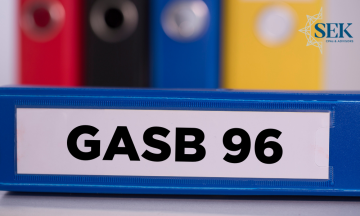Recent News & Blog / GASB 96 - What is a SBITA and how will our governmental entity implement this standard?

June 13, 2023
By: Kevin Stouffer, CPA
Member of the Firm
In May 2020, the Governmental Accounting Standards Board (GASB) issued Statement No. 96 for Subscription-Based Information Technology Arrangements (SBITA) for government end users (governments). Many were left wondering after the Statement was issued: What is a SBITA and how will our governmental agency implement this standard?
GASB defines a SBITA as a contract that conveys control of the right to use another party’s information technology (IT) software, alone or in combination with tangible capital assets (the underlying IT assets), as specified in the contract for a period of time in an exchange or exchange-like transaction. In more layman’s terms, this standard is the fraternal twin of GASB Statement No. 87 for Leases. Many provisions are the same or similar to those for leases that has been implemented by governmental entities over the past year.
To further describe the standard, it should be noted that in order to “convey control of the right to use the underlying asset,” a contract should have both of the following:
- The right to obtain the present service capacity from use of the underlying IT asset
- The right to determine the nature and manner of use of the underlying IT asset
Similar to GASB 87, the biggest challenge facing most governmental entities will be gathering and evaluating their SBITA population and verifying completeness. For larger governments, there are many SBITAs that vary across multiple departments within their organization for a wide range of services. All departments of each government should be involved in the process of searching for SBITAs in combination with the IT and accounting departments for evaluation.
Thankfully, most of the experience gained from GASB 87 can be applied to the implementation of GASB 96. Contracts will be reviewed for key information, such as payment types (fixed or variable), term of the subscription, options to terminate or renew, and evaluation against the government’s capitalized threshold, reasonable certainty, and materiality.
The most significant difference from GASB 96 and GASB 87 is the accounting for different costs in the SBITA lifecycle. The outlays other than subscription payments in the implementation phase of a SBITA can be applied to the following stages:
- Preliminary Project Stage – includes formulating and evaluating alternatives, the determination of existence of needed technology, and the final selection of final alternatives for the SBITA. These expenditures are expensed as incurred.
- Initial Implementation Stage – includes the design, configuration, code, installation, and testing associated with the underlying IT assets. Further, any additional costs to convert data needed to make the underlying assets operational are included in this stage. These costs will be capitalized as an addition to the subscription asset, unless there is no subscription asset (for example, if the contract is a short-term SBITA).
- Operational and Additional Implementation Stage – includes costs to train users, maintenance, troubleshooting, and other activities related to the government’s ongoing access to the underlying IT assets. These costs will be expensed as incurred. However, if a new module is added after the subscription asset and is placed into service, the costs may be capitalized as an addition to the subscription asset if certain criteria are met.
GASB 96 for SBITAs is effective for fiscal years beginning after June 15, 2022, and now is the time to evaluate and implement the pronouncement.
SEK's governmental team is here for you. If you have questions need assistance, complete the form below and we'll be in touch shortly!